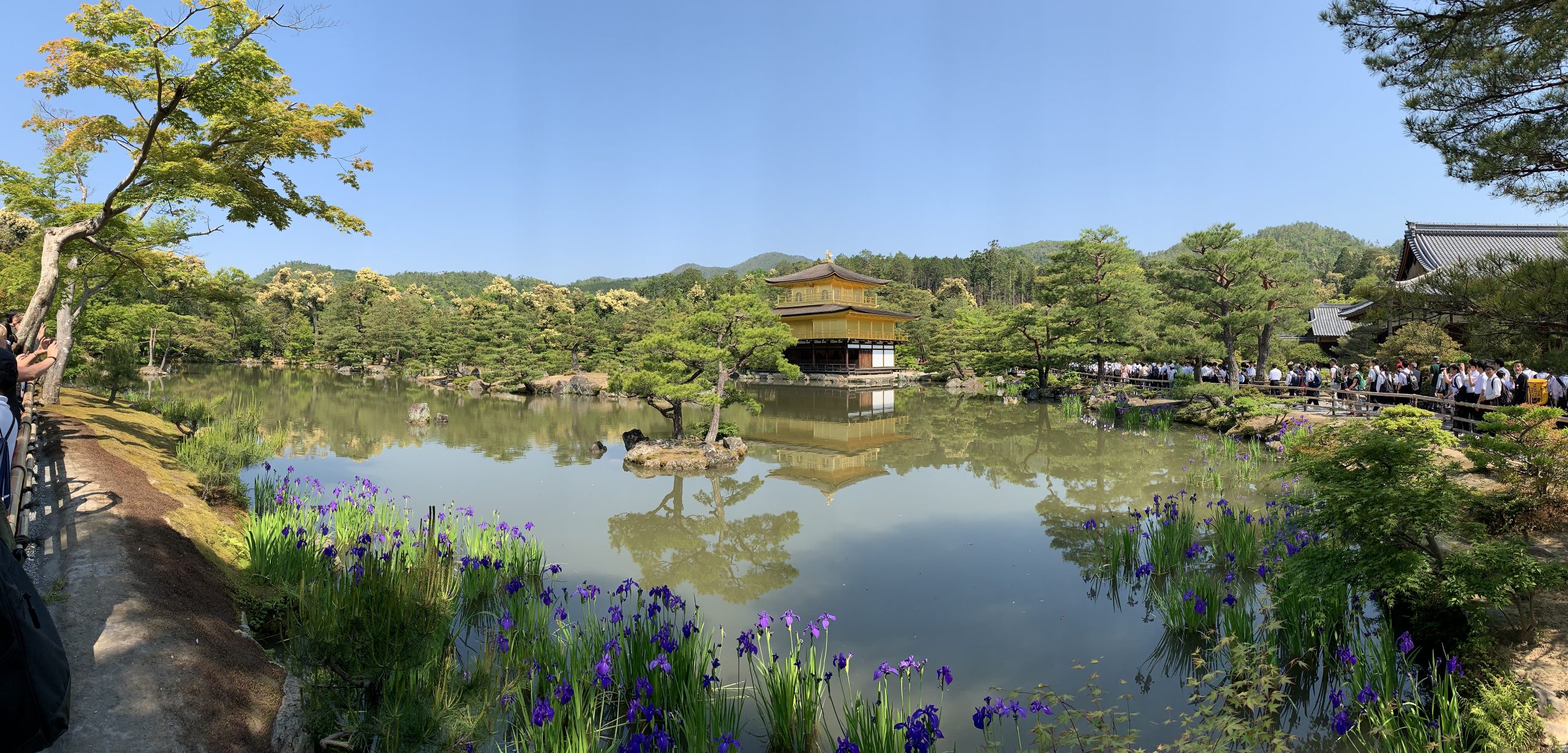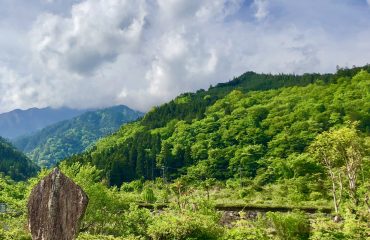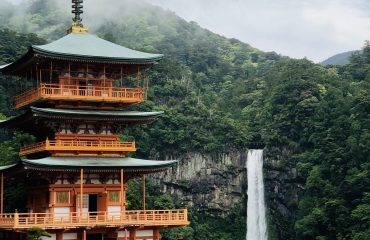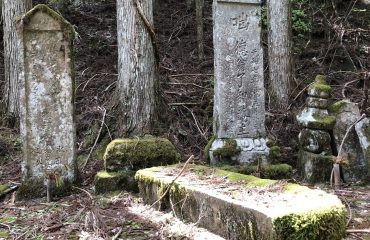Exploring Kyoto’s Top Sights
With so many “must-see” temples, shrines and gardens in Kyoto, visiting them all can be intimidating. We gave ourselves a full week (also helpful given the early days of jet lag), so we had no reason to hurry. Rushing from place to place has never been our style anyway. Instead, we take our time and relax into the place we’re visiting, giving ourselves time to explore less-traveled places.
In Kyoto our plan was to visit one of the big attractions a day – or two if they were clustered in one neighborhood. We arrived in the early morning when crowds are lighter, and then spent the rest of the day exploring less-traveled areas.
By the way, a large part of the crowds at these sights are Japanese schoolchildren on group trips. There were many, but we found them delightful, interviewing us several times for school projects. All in all, we found the crowds manageable, partly because we arrived in early May, a few days after the end of Golden Week, the string of holidays that come right after cherry blossom season.

Kiyomizu-Dera and Chion-In
One of the advantages of staying in Gion, is having two of Southern Higashiyama’s main attractions—Kiyomizu-Dera Temple and Chion-In—in walking distance. On our first day, we decided to stay close to home and set out at 7:30 am for Kiyomizu-Dera, turning up from Higashioji-dori and walking 10 minutes uphill past shops and restaurants that had yet to open.
Though the more spectacular sights were to come in the days ahead, Kiyomizu-Dera literally means pure water and this temple has special meaning in Kyoto and all of Japan. It was the first temple we visited, so the walk through the Gate of the Deva Kings, the stop at our first purification fountain, and the climb up the stairs and through the temple grounds was special.
Kiyomizu-Dera offers dramatic views over Kyoto and the hills. It was cloudy (the last day without sun for a while), and the main hall, which has a wooden stage that juts out over the hills, was covered for renovations. But inside the temple we found the eleven-faced, thousand-armed Kannon (no photos allowed), and on the way out was the Jishu Shrine, where two stones are placed 18 meters apart. If you can walk eyes closed from one to the other, it brings you luck in finding love. It was a great start to our trip.
We waited until our last day to visit Chion-In, about a 15-minute walk from our Gion guesthouse. Chion-In is connected to Honen (1133-1212), the founder of the Jodo Shu (Pure Land Sect) of Buddhism and the one who made Buddhism something for the masses. Although the main hall was closed for renovations, the exteriors of the sprawling temple were dramatic and well worth a visit.
From the massive main gate to the two gardens (you can buy a ticket for one or both) – Hojo Garden and Youzen-en Garden – we toured it’s easy to spend a few hours here on a nice day.
Fushimi Inari-Taisha
Fushimi Inari-Taisha is a Shinto shrine in Southeastern Kyoto that is made up of thousands of vermillion entrance gates (torii) that meander 4km up Mt. Inari to the summit. It’s nothing less than spectacular, and like many of the sites, the sheer scale of gate after gate winding up a mountain is impossible to capture in photos (though we tried).
While a good number of people were entering the shrine when we did, there was little foot traffic as we ascended the mountain and encountered warning signs to avoid the monkeys and wild boar. The shrine was dedicated to the gods of rice and sake in the 8th century, and along the way are hundreds of sub shrines and stone foxes, considered to be the messengers of the Shinto god Inari.
Getting There: Fushimi Inari is a quick trip from Gion. It’s a five-minute walk to the Gion train station, then five stops on the Keihan Main Line (toward Yodoyabashi) to the Fushimi-Inari stop, and another five-minute walk to the shrine – with a quick stop at a nice café for a jet-lag-battling espresso.
Arashiyama
We followed up our day at Fushimi-Inari with a morning in Arashiyama in western Kyoto to visit the Bamboo Grove and Tenryu-ji Temple.
Tenryu-ji (Temple of the Heavenly Dragon) is a major temple of the Rinzai School. You find a wonderful Zen landscape garden and reflecting pond all set against the backdrop of the Arashiyama mountains. The temple has been ravaged by fire and rebuilt eight times since it was built in 1343, but the landscape garden is one of the oldest in Japan and retains the same form as when it was designed by Muso Soseki in the 14th century.
While it makes sense to start your day at Tenryu-ji and then exit on the north side to the Bamboo Grove, consider starting at the Bamboo Grove first before the crowds arrive. Why? It’s a magical stroll through the towering bamboo trees, sun glistening through the leaves, and the fewer people the better. Don’t worry about capturing it in photos because anything you take will pale in comparison to walking quietly and feeling its immense beauty.

Getting There: To get to Arashiyama, we walked half a mile to Downtown Kyoto and the Kawaramachi station on the Hankyu Railway toward Hankyu-Umeda. At Katsura, we transferred to the Arishiyama line and exited at the last stop, Arishiyama. From the train station, it’s a lovely 15-minute walk across a bridge and through town to reach Tenryu-ji Temple and the Bamboo Grove. And exiting the train in the downtown on the way back gave us our first chance to stop at Nashiki Market (more on this in an upcoming blog).
Northwest Kyoto
After a day off from the big sights, we tackled the two impressive sights in Northwest Kyoto on day five.
The gold-plated main hall of the Kinkaku-ji (Golden Pavilion) is a thing of beauty that – unlike many of the sights in Kyoto – has a scale easily captured in photos. It was originally built in 1397 as a retirement villa for shogun Ashikaga Yoshi-mitsu and later converted to a Buddhist temple. Looming above a splendid reflecting pond, it has an other-worldly quality that should keep you planted in one spot, your eyes scanning the scene, for a while. And if it’s on a sunny morning like we had, it’s hard to beat its peaceful beauty.
Nearby is Ryoan-Ji, a Zen temple with an iconic rock garden where you can sit and contemplate (crowds permitting) the arrangement of the 15 rocks that rest on white gravel. It’s 25 meters from east to west and 10 meters from north to south, and the walls are made of clay boiled in oil. As the oil seeped out, it created its own design. The rock garden was said to be created around 1500 by a Zen monk, but there are differing accounts.

Getting There: This was our first time taking the bus, and it wasn’t too difficult as long as you know your stop. All the bus lines were a flat rate of 230 yen. We took the number 12 bus about 40 minutes, and from the Golden Pavilion you can catch a bus or walk to Ryoan-Ji. We walked and caught the bus back to Gion.































